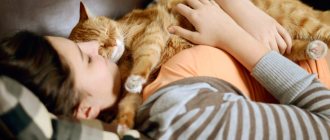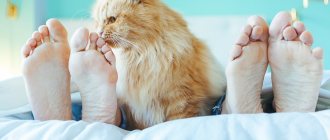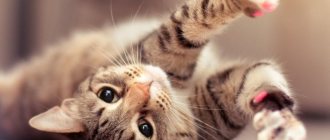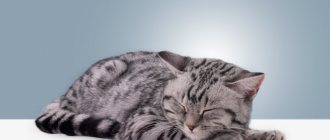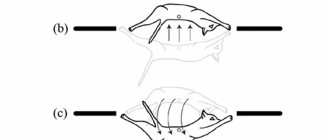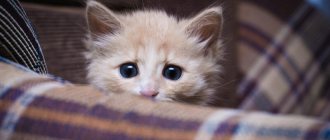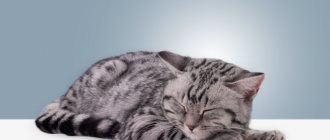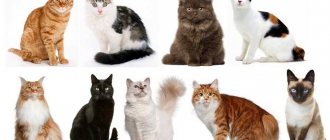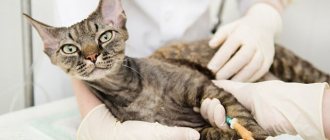Just because you and your cat speak different languages does not mean you cannot communicate successfully. People and cats have a special connection that has developed over centuries. Your cat can easily communicate its needs or mood to you using posture, tail movement, and gaze. You just need to be able to decipher these simple signals.
Cats are active and curious creatures. During the day they can make hundreds of different movements. But furry pets make some movements precisely in order to “say” something to their owner.
The cat sits with its paws tucked
You can see a cat in this position very often. This position of the cat’s body indicates that he feels cozy, comfortable and comfortable in the house. The animal is relaxed and just resting, dozing off. Paws tucked under the chest show that the cat is confident that she will not have to use her claws in the near future.
It is not advisable to disturb the cat at this moment. She will not show aggression, but she will not be happy with the owner’s intervention. It is worth picking up a cat sitting with its front paws tucked in only to, for example, carry it onto your lap and stroke it. The main thing is not to spoil the animal’s relaxed mood.
Behavior after sterilization and castration
The cat is not only an affectionate pet, it is considered one of the most dangerous predators for its size. Therefore, cat aggression can be dangerous for other pets and for humans.
One of the reasons for aggressive behavior is sexual activity. Failure to satisfy this need leads not only to behavioral disorders, but also to nervous disorders. The problem is solved by castration or sterilization.
After surgery, the animal behaves unusually. First, it recovers from the anesthesia and sleeps a lot. Experienced stress and discomfort from surgery often lead to refusal of water and food for the whole day.
It is safer to spend the first day in a carrier under the supervision of the owner. This will protect against possible injuries. The effects of anesthesia often lead to inappropriate behavior, loss of coordination, and changes in perception. In this state, the cat runs the risk of falling out of the window or falling off tall objects.
Even a litter-trained pet may suddenly “forget” its toilet after surgery. Don't scold him. The reason for this behavior is the stress experienced. In addition, the usual tray and filler may seem uncomfortable to the pet during the healing of the sutures. Be tolerant of the animal, try to calm it down. You may need to temporarily replace the litter or tray. Don't overdo it with hygiene: too thorough cleaning of the toilet destroys the animal's usual smell. Detergents cause allergies or skin irritation.
Animals that have been sterilized when young are more likely to become affectionate and do not show aggression. An operation in adulthood affects character less noticeably: it has already been formed. But most neutered animals are less prone to mood swings and get along better with other pets. Some cats become more aggressive immediately after surgery. This is a reaction to stress and discomfort.
Be patient, provide a calm, comfortable environment, and pay more attention to your pet. He needs time to recover and calm down. If behavioral disturbances or depression do not go away after a month, contact your veterinarian.
Don't forget about proper nutrition. It is necessary to restore and maintain health after surgery. Consult your veterinarian, he will help you create a diet. PRO PLAN® VETERINARY DIETS CN CONVALESCENCE is ideal for nutrition after surgery. It is well absorbed thanks to the special formula. And the high calorie content and increased protein content will support the pet’s body during the recovery period. PRO PLAN NUTRISAVOUR STERILISED food has been developed for feeding sterilized and neutered animals. It supports the health of the urinary system thanks to its high moisture content and a complex of minerals. Antioxidants enhance the body's natural defenses. And the special formula helps maintain a healthy weight: it contains a lot of protein and little fat.
Read more about sterilization of cats and female cats in our article.
The cat comes to sleep at your feet
There is nothing strange or special about the fact that a cat comes to sleep at the feet of its owner. Fluffy pets generally love to sleep next to their owners. In this case, they feel safer. If a cat comes to sleep at your feet, this is a sign that she completely trusts you.
Agatha in love: Klim Shipenko denied rumors of an affair with Muceniece
Alexey Pimanov’s third marriage: how a meeting with Pogodina changed their destinies
Doesn’t let go, but doesn’t invite you to marry: how to recognize your partner’s type of affection
Also, since the cat in this case does not lie down directly next to you, but at some distance, it means that she also wants to retain freedom of action. The animal lying at the feet can get up and go about its business at any time.
If your cat loves to sleep on your feet but never does the same with other family members, congratulations. You are the beloved owner of a furry pet.
Possible pathological disorders
Unfortunately, diarrhea and dirty fur are not the only factors that cause a cat to ride on its butt. There are also more serious factors that lead to this behavior, for example:
- mental health disorder;
- post-traumatic stress disorder;
- helminthic infestation;
- paraanal inflammation.
Each of the diseases deserves attention and requires consultation with a veterinarian. In addition, they are accompanied by other symptoms, in addition to “travels on the fifth point”.
Signs of mental disorder
With mental disorders caused by stress, the pet's behavior changes noticeably and becomes strange. The cat can:
The owner may notice that the pet begins to crawl on the floor, regardless of toilet procedures. In this case, it is recommended to immediately contact a specialist who will identify the pathology and prescribe appropriate therapy.
Phantom pain syndrome
After an injury to the hind legs or a fracture of the hip joint, the pet begins to look for a way to eliminate phantom soreness. He rolls on the floor, trying to get rid of the pain that is lingering in his brain. In such a situation, veterinarians prescribe medications that have a mild sedative effect to the animal. They help him cope with excruciating post-traumatic discomfort.
Parasite infestation
Most often, pets get pinworms and tapeworms, which live in the large intestine. To reproduce, many of them have to crawl to the entrance to the anus to lay eggs. This process is accompanied by a feeling of severe itching, which the pet tries to get rid of by crawling on the floor.
When infected with tapeworms, a feeling of bloating occurs in the intestines. The cat strives to get rid of feces, stimulating the anus while riding on the floor and causing defecation. To save your pet from such difficulties, you should regularly deworm it, using anthelmintic drugs for preventive purposes. These can be tablets for oral administration, drops on the withers area or other means.
Blockage of the anal glands
Mustachioed striped animals have anal glands, which are muscular sacs located in close proximity to the anus. They constantly produce secretions that are released through the ducts during bowel movements. It gives feces and urine a specific odor, allowing cats to leave “fragrant” marks on their territory.
Norm and deviations. In its normal state, the secretion is a thick, odorous substance. If the glands are not completely emptied, then corresponding disorders arise:
- the tissues of the muscle sacs are “overstretched”;
- irritation occurs in the glandular ducts;
- dermatological problems arise - small inflamed seals and bald spots form in the neck and along the spine;
- the paraanal glands swell greatly and become visible under the animal’s tail.
Consequences. If the owner does not pay attention to the blockage in time, then the disruption of circulation ends with the formation of a fistula and the penetration of the contents of the glands into the peritoneum.
The cat sleeps curled up
Cats curl up when they want to keep warm. This does not mean that the cat is cold in the room and is experiencing discomfort. In fact, the animal just wants to be warmer and more comfortable while sleeping. This position is the same as covering a person with a blanket while sleeping.
Fan of Pushkin? Why did Georges Dantes often quarrel with his daughter?
Hotel in the trees: an unusual resort complex lost in the thicket of an Indian forest
Left his family, went to Minsk: how Mireille Mathieu changed the life of Vladimir Gostyukhin
The cat is sitting, looking at something unknown
Some people believe that cats can see otherworldly things. In reality this is, of course, not the case. Cats have very acute vision. They see better than humans. And the cat may just be looking at some midge that you don’t notice.
Forgiveness Sunday (March 14): what not to do on the big holiday
Why did Vladimir Mashkov’s daughter move to the USA and how does she live now?
Pancakes for Maslenitsa should be perfect: how to prepare and filling options
Tags
fold-eared cat fold-eared cat for a cat with their own fold-eared cats fold-eared cats absolutely fold-eared cats calm fold-eared cats get along fold-eared cats get along this breed is squat this breed is very this breed will be this breed is inclined this breed. beautiful breeds of cats BREEDS that cats try for cats and if the cat is calm in which in which this cat for the breed is broken very devoted you need to try very hard. they very resistant, fold-eared cats, non-fold-eared cats, the body of cats for all cats. breeds of cats Scottish cats and
answersyouryearcharactercarethe main thingeyesduemyalwaysfolded
The cat is frightened by sudden movements of the owner and runs away
Sometimes it happens that a cat shows love and trust to its owners, but with sudden movements, for example, if the owner quickly gets up from a chair or waves his hand in a conversation, he gets scared and runs away. Fostered outdoor cats or animals that were abused by their previous families often behave this way.
The risk of developing atherosclerosis and more: how pancakes with sour cream harm your health
Creating fashionable pink looks for spring 2021: photo examples
The brightness of neon is the trend of 2021: creating stylish looks for spring
If your cat behaves this way, try to calm him down by petting him and holding him in your lap. Over time, the animal will no longer be afraid of your sudden movements.
Cat's tail tongue: tail held high
The easiest way to guess a cat's intentions and mood is by observing its tail. If a cat walks around the house with its tail held high, it expresses confidence and satisfaction. The cat is happy and ready to make friends and communicate with all the people in the house. If the tip of the cat's tail twitches a little at the same time, it means that she is especially happy with life.
At this moment it is worth playing with the cat. She is in an extremely good mood and you should definitely take advantage of it.
Scottish Fold health
Scottish Fold cats have a breed tendency to diseases of the musculoskeletal system. The gene that provokes pathological changes in the skeletal system is linked to the lop ear gene. Cats with short thick tails and inflexible paws are most prone to musculoskeletal disorders. It is necessary to monitor the health of such pets more closely, regularly visit the veterinary clinic with them and strictly adhere to the diet prescribed by the veterinarian.
But in general, the Scottish Fold is in good health, especially if the breeders from whom the kitten was purchased followed all the nuances of selecting a pair to produce offspring. The average lifespan of Scottish Folds is 12-15 years, but among the representatives of this breed there are many long-livers who have surpassed the 18 year mark.
To protect a cat from viral and infectious diseases, standard vaccination, periodic deworming and protection from external parasites - insectoacaricidal drops, collars, sprays - are required.
Why do cats hide?
Cats are excellent hunters and are good at hiding. Of course, the owner may think that the cat doing this simply wants to play hide and seek. But in reality there can be many reasons for this behavior.
Although cats are predators, in many cases they try to avoid confrontation. When frightened, the animal will most likely run away and hide. By retreating in this way, the cat gives itself space to maneuver, a subsequent possible attack and fight for the purpose of defense.
Cats can also hide if they have just arrived in a new home. The same behavior is often observed in cats when the owners suddenly change something in the house. For example, they bring new furniture or rearrange old ones. A new stranger appearing in the house can also cause a similar reaction.
Methods for cleaning the anal glands
Veterinarians can help you deal with the problem of blocked anal glands. Moreover, representatives of some breeds require regular cleaning - 1-2 times every 4-5 weeks:
- The veterinarian, using mechanical force, cleans the ducts, removing excess or thickened secretions.
- If the wounds are infected and inflamed, the cat is prescribed a comprehensive treatment: antibiotics, diet food and rectal suppositories.
- In case of advanced disease, when the mucous tissues are necrotic, surgical intervention is necessary. The affected membranes are excised.
The duration of therapy can vary from 8 weeks to 6 months.
There is a possibility of relapse, so it is recommended to visit the veterinary clinic periodically.

